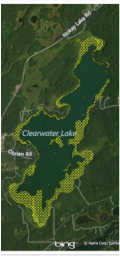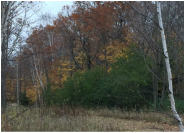|
What are Invasive Species
 Total Littoral area: 331.76 Acres Total Littoral area: 331.76 Acres
Invasive species are plants, animals, and other organisms either accidentally or intentionally introduced from other places. Once established, invasive species can have a large negative impact on the environment. Due to the lack of natural controls and high reproductive ability, invasives can quickly become widespread.
Aquatic Invasive Species are know as AIS. Clearwater lake has identified three Aquatic Invasive species; Eurasian Milfoil, Curly Pond Leaf and Rusty Crayfish. We were tested in 2016 for Zebra muscles and came back clean. Areas at the highest risk in a lake is the littoral area ( 0 - 15 feet ). We also have a land plant called Buckthorn that is encroaching on our forests in the area. Eurasian MilfoilEurasian Milfoil was discovered on Clearwater Lake around 2008. Clearwater was formally recognized as in infested lake by the DNR 2011. The invasive plant population exploded in 2014 and we began an active treatment plan that year. The DNR reports on the location of the Milfoil show it rapid spread.
Although we have not eliminated the Eurasian Milfoil, Clearwater Lake is looking like a success story! See the Treatment Plan and the results. Curly-Leaf Pondweed -
A small batch of Curly-Leaf Pond Weed was discovered on the south side of the lake in the spring of 2016 when RMB was doing the spring survey for milfoil. It was a very small batch, so small that RMB thought it might have been brought here by a bird.
It was treated in the Spring of 2016 and the area has been closely monitored and no Curly-Leaf Pondweed has been evident. Unfortunately, in the early summer of 2021 a large patch (roughly 20 foot diameter) was found in front of the "A" frame house on the SW bay of the lake. We discussed treatment options for this new invasive. It should be treated in the spring when the water is between 50 - 60 degrees. We missed this window in 2021 and decided to wait and watch in 2022. The patch appears to have cleared itself up so no treatment has been done for this invasive since 2016. The Clearwater Lake Conservancy continues to monitor this area to prevent this invasive from becoming a larger problem. Rusty CrayfishRusty Crayfish are pervasive in our lake. The general theory is they were spread throughout the Midwest in the 1950's and 60s when they were used by fishermen as bait.
When you watch the lake floor along the shoreline, you can see them scurry across the sand. The larger crayfish are the Rusty. Think it is time for a Crayfish boil guys! In recent years the "observed" opinion of our Rusty's is that they appear to be in decline. The Clearwater Conservancy Board it looking at ways to quantity this opinion. Buckthorn Shrubs
 Photo by Jeff Zernov Photo by Jeff Zernov
Buckthorn are shrubs that grow into small tress, up to 20-25 feet tall. They they are invading our oak forests, savannas, prairies, old fields and roadsides. They thrive on well-drained soils. They leaf out early and retain their leaves until until late fall (November). This creates a dense shade that is harmful to many native plants.
There are two kinds of invasive Buckthorn; Common Buckthorn and Glossy Buckthorn. |


